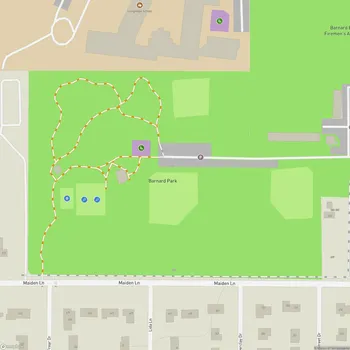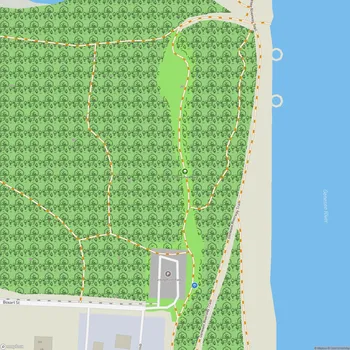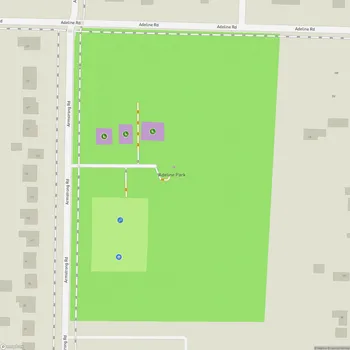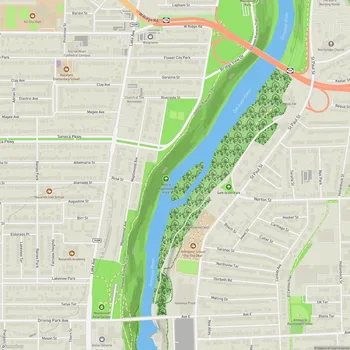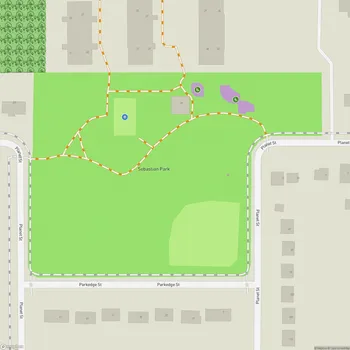Seneca Park
Interactive Park Map
About Seneca Park
A Historic Green by the River
Seneca Park is a sprawling 297-acre green space in Rochester, New York that dates back to 1893. Designed by the legendary Frederick Law Olmsted (the same mind behind NYC's Central Park!), it was originally called North Park before being renamed to honor its Native American heritage and the impressive stone formations in the river gorge.
Straddling both sides of the Genesee River, this park has not only provided public access to the water but has also protected this beautiful area from development for generations. In 2003, it earned a well-deserved spot on the National Register of Historic Places as an important piece of Rochester's park system heritage.
Nature's Canvas
One of the first things you'll notice about Seneca Park is its elevated position along the eastern bank of the Genesee River, offering some truly breathtaking views of the river gorge below. At the heart of the park sits Trout Lake (though locals often call it Duck Lake), an artificial lake created by damming a natural spring. It's become a wonderful centerpiece, surrounded by peaceful picnic groves and open meadows.
The lake itself is a hub of activity for various waterfowl. Ducks, geese, and swans call this place home year-round. There's something particularly special about watching the swan families raise their cygnets throughout the changing seasons.
As you explore further, you'll discover rolling woodlands, open fields, and hiking trails that wind along the edge of the gorge. If you're not up for a hike, the one-way carriageway curves gently through the park, letting you take in the natural beauty from the comfort of your car.
The northern section feels almost like wilderness, with diverse trees including sassafras, hickory, maple, oak, and horse chestnut creating a natural canopy. Keep your eyes peeled and you might spot beavers or various bird species going about their day.
Trails for Every Explorer
Whether you're a serious hiker or just looking for a casual stroll, Seneca Park offers various options. Several well-marked trails crisscross the park, with some ambitious routes stretching all the way to Lake Ontario for those seeking a longer adventure.
For something more relaxed, the paved path around the pond offers an accessible one-mile loop that's ideal for a quick workout or a leisurely walk. If you're feeling more adventurous, follow the red-flagged forest trails that lead you deeper into the park's natural areas.
Fishing enthusiasts will appreciate the stocked pond - just find a quiet spot along the shore, cast your line, and enjoy the peaceful surroundings. It's a simple pleasure that draws people back regularly.
Amenities for Everyone
Planning a gathering? The park offers several picnic shelters and pavilions that make perfect venues for get-togethers. For larger events like family celebrations, Wegman Manor provides a more spacious option.
Kids will love the natural wood playground that blends beautifully with the park's aesthetic while providing plenty of fun. And yes, there are clean restroom facilities available around the park, including inside Wegman Manor.
You'll discover ample parking across the grounds, and the overall maintenance of the park speaks to the care put into preserving this historic space.
Meet the Neighbors at Seneca Park Zoo
Taking up about 20 acres of the park is the Seneca Park Zoo, established in 1894. Though it's part of the same space, the zoo sits at a higher elevation and is surrounded by woodland plantings that create a natural separation from the rest of the park.
Here you can observe an impressive array of animals, including wolves, lions, and elephants. The zoo occasionally hosts animal shows and demonstrations that are both entertaining and educational for visitors of all ages.
Over the years, the zoo has undergone significant evolution, consistently improving animal habitats and visitor amenities. If you're planning multiple visits, their family membership plans offer good value and make for an easy way to connect with nature during the year.
All Features & Facilities
Nature & Wildlife
Water Features & Activities
Visitor Services
Food & Gathering
Photo Gallery
ParkMagnet Score
Top Park
Park Size
Opening Hours
Weather
Top Restaurants Near Seneca Park
Mark's Pizzeria
0.8 miles563 Titus Ave, Irondequoit, NY 14617
Local pizzeria chain serving classic and creative pizzas alongside wings and submarine sandwiches.
